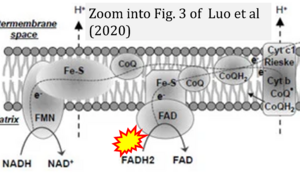Luo 2020 Int J Mol Sci
From Bioblast
| Luo Y, Ma J, Lu W (2020) The significance of mitochondrial dysfunction in cancer. Int J Mol Sci 21:5598. https://doi.org/10.3390/ijms21165598 |
Luo Y, Ma J, Lu W (2020) Int J Mol Sci
Abstract: As an essential organelle in nucleated eukaryotic cells, mitochondria play a central role in energy metabolism, maintenance of redox balance, and regulation of apoptosis. Mitochondrial dysfunction, either due to the TCA cycle enzyme defects, mitochondrial DNA genetic mutations, defective mitochondrial electron transport chain, oxidative stress, or aberrant oncogene and tumor suppressor signaling, has been observed in a wide spectrum of human cancers. In this review, we summarize mitochondrial dysfunction induced by these alterations that promote human cancers.
• Bioblast editor: Gnaiger E
Hydrogen ion ambiguities in the electron transfer system
Communicated by Gnaiger E (2023-10-08) last update 2023-11-10
- Electron (e-) transfer linked to hydrogen ion (hydron; H+) transfer is a fundamental concept in the field of bioenergetics, critical for understanding redox-coupled energy transformations.
- However, the current literature contains inconsistencies regarding H+ formation on the negative side of bioenergetic membranes, such as the matrix side of the mitochondrial inner membrane, when NADH is oxidized during oxidative phosphorylation (OXPHOS). Ambiguities arise when examining the oxidation of NADH by respiratory Complex I or succinate by Complex II.
- Oxidation of NADH or succinate involves a two-electron transfer of 2{H++e-} to FMN or FAD, respectively. Figures indicating a single electron e- transferred from NADH or succinate lack accuracy.
- The oxidized NAD+ is distinguished from NAD indicating nicotinamide adenine dinucleotide independent of oxidation state.
- NADH + H+ → NAD+ +2{H++e-} is the oxidation half-reaction in this H+-linked electron transfer represented as 2{H++e-} (Gnaiger 2023). Putative H+ formation shown as NADH → NAD+ + H+ conflicts with chemiosmotic coupling stoichiometries between H+ translocation across the coupling membrane and electron transfer to oxygen. Ensuring clarity in this complex field is imperative to tackle the apparent ambiguity crisis and prevent confusion, particularly in light of the increasing number of interdisciplinary publications on bioenergetics concerning diagnostic and clinical applications of OXPHOS analysis.
Labels: Pathology: Cancer



